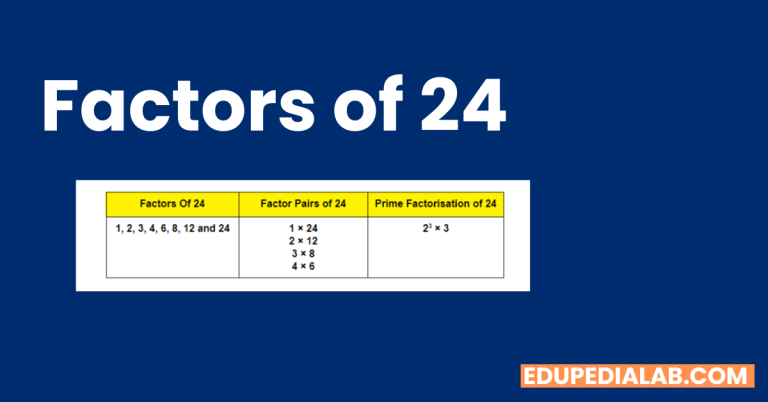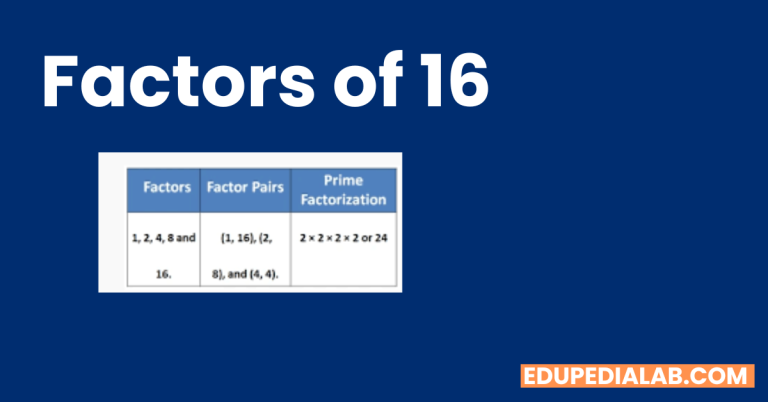Factors Of 25 (Explained By Experts)
Factors of 25
Welcome to our comprehensive guide on the factors of 25! In this article, we will delve into the world of numbers and uncover the fascinating properties of the number 25. We will explore its factors, or divisors, which are the numbers that evenly divide into 25. Whether you are a math enthusiast or simply curious about numbers, this article will provide you with a deep understanding of the factors of 25 and their significance. So, let’s dive in and unlock the secrets of this intriguing number. The number 5 is common when we Look at the Factors Of 10, Factors Of 15, and Factors Of 25.

Factors Of 25: Understanding the Basics
To begin our exploration of the factors of 25, let’s first define what factors are. Factors are whole numbers that divide into a given number without leaving a remainder. In the case of 25, the factors are the numbers that divide into 25 evenly and produce whole number quotients. For example, the factors of 25 are 1, 5, and 25. Let’s take a closer look at each of these factors and their properties.
Factor 1: The Smallest Factor
The number 1 is always a factor of any given number, including 25. This is because dividing any number by 1 will always result in the original number itself. In the case of 25, when we divide it by 1, we get 25 as the quotient.
Factor 5: The Second Factor
The number 5 is another factor of 25. When we divide 25 by 5, the quotient is 5. It is interesting to note that factor 5 is the only prime factor of 25. Prime numbers are numbers that have only two factors: 1 and the number itself. In this case, 5 is a prime factor of 25 because it has no other divisors apart from 1 and 5.
Factor 25: The Third Factor
The number 25 itself is also a factor of 25. When we divide 25 by 25, the quotient is 1. It is important to remember that every number is always a factor of itself. This property holds true for 25 as well.
Exploring the Multiples of 25
Now that we have covered the factors of 25, let’s shift our focus to the multiples of 25. Multiples are the numbers that result from multiplying a given number by another whole number. In the case of 25, the multiples are obtained by multiplying 25 by different whole numbers. Let’s examine a few multiples of 25 and their significance.
Multiple 25: The First Multiple
The first multiple of 25 is, unsurprisingly, 25 itself. When we multiply 25 by 1, the product is 25. Multiplying a number by 1 always results in the original number.
Multiple 50: The Second Multiple
The second multiple of 25 is 50. When we multiply 25 by 2, the product is 50. Multiples of 25 increase by increments of 25 with each multiplication.
Multiple 75: The Third Multiple
The third multiple of 25 is 75. When we multiply 25 by 3, the product is 75. Each subsequent multiple of 25 is obtained by multiplying 25 by the next consecutive whole number.
FAQs about Factors Of 25
FAQ 1: Are the factors of 25 limited to 1, 5, and 25?
No, those are the basic factors of 25, but it is important to note that every positive number has at least two factors: 1 and the number itself. In the case of 25, since it is a perfect square, its factors are limited to 1, 5, and 25.
FAQ 2: Can we find more factors of 25?
While the factors of 25 are limited to 1, 5, and 25, we can find other divisors of 25 that are not considered factors. These divisors may not divide 25 evenly but are still worth exploring. For example, -1, -5, and -25 are divisors of 25, but they are not typically considered factors because they do not produce positive whole number quotients.
FAQ 3: What is the significance of the factors of 25?
The factors of 25 are significant in various mathematical applications. For instance, when solving quadratic equations, the factors of 25 can play a crucial role in finding the roots of the equation. Additionally, the factors of 25 are useful in prime factorization, where we break down a number into its prime factors to simplify calculations or solve problems.
FAQ 4: How can we determine the factors of any number?
To determine the factors of any given number, including 25, we can use a systematic approach. We start by finding the two smallest factors, 1 and the number itself. Then, we check for other possible factors by dividing the number by progressively larger whole numbers. If the division results in a whole number quotient, then the divisor is a factor. By continuing this process, we can identify all the factors of a given number.
FAQ 5: Are factors and multiples related?
Yes, factors and multiples are closely related concepts. Factors are the numbers that divide into a given number without leaving a remainder, while multiples are the numbers obtained by multiplying a given number by another whole number. Every factor of a number is also a divisor, and every multiple of a number is a product. In the case of 25, its factors are 1, 5, and 25, while its multiples are obtained by multiplying 25 by different whole numbers.
FAQ 6: How can knowledge of the factors of 25 be applied in real-life scenarios?
The knowledge of the factors of 25, as well as factors of other numbers, can be applied in various real-life scenarios. For example, when working with fractions, understanding the factors of the numerator and the denominator helps in simplifying and reducing the fraction to its lowest terms. Additionally, factors are fundamental in determining the common factors between numbers, which is useful in tasks like simplifying ratios or finding the greatest common divisor (GCD) of two or more numbers.
Conclusion
In conclusion, the factors of 25 are 1, 5, and 25. These numbers divide into 25 evenly and produce whole number quotients. Understanding the factors of 25 allows us to explore the relationships between numbers and apply this knowledge in various mathematical contexts. Additionally, we have also discussed the concept of multiples and their connection to factors. By delving into the factors of 25, we gain a deeper appreciation for the intricacies and patterns that numbers hold.
So, the next time you encounter the number 25, remember its factors and the role they play in mathematical operations. By harnessing the power of factors, you can unlock a deeper understanding of numbers and their relationships.






